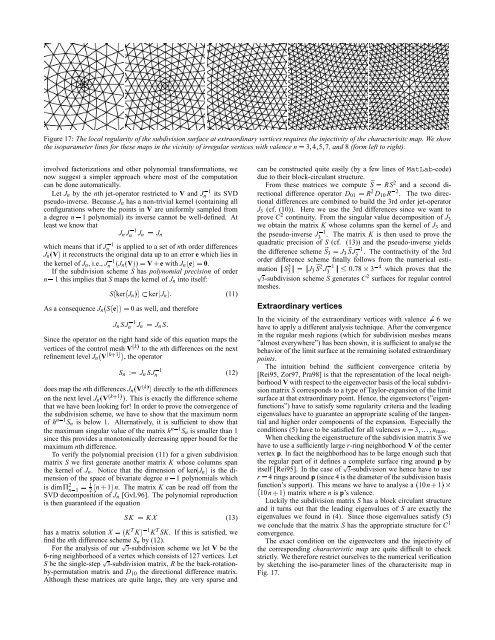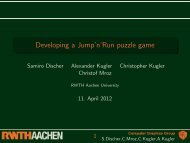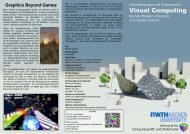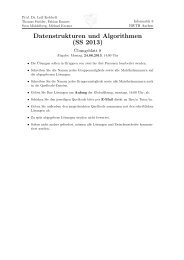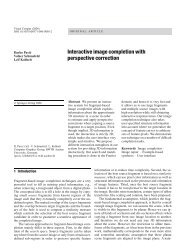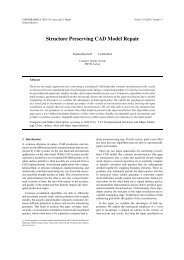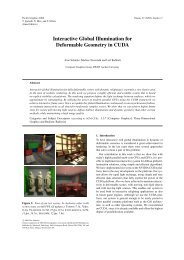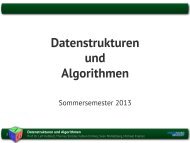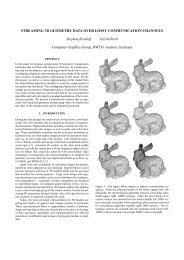sqrt(3) subdivision - Computer Graphics Group at RWTH Aachen
sqrt(3) subdivision - Computer Graphics Group at RWTH Aachen
sqrt(3) subdivision - Computer Graphics Group at RWTH Aachen
Create successful ePaper yourself
Turn your PDF publications into a flip-book with our unique Google optimized e-Paper software.
Figure 17: The local regularity of the <strong>subdivision</strong> surface <strong>at</strong> extraordinary vertices requires the injectivity of the characterisitc map. We show<br />
the isoparameter lines for these maps in the vicinity of irregular vertices with valence n 3¤ 4¤ 5¤ 7, and 8 (form left to right).<br />
involved factoriz<strong>at</strong>ions and other polynomial transform<strong>at</strong>ions, we<br />
now suggest a simpler approach where most of the comput<strong>at</strong>ion<br />
can be done autom<strong>at</strong>ically.<br />
Let J n by the nth jet-oper<strong>at</strong>or restricted to V and J¥1<br />
n its SVD<br />
pseudo-inverse. Because J n has a non-trivial kernel (containing all<br />
configur<strong>at</strong>ions where the points in V are uniformly sampled from<br />
a degree 1 polynomial) its inverse cannot be well-defined. At<br />
n¦<br />
least we know th<strong>at</strong><br />
J n J¥1<br />
n J n J n<br />
which means th<strong>at</strong> if J¥1<br />
n is applied to a set of nth order differences<br />
J n V¥ it reconstructs the original d<strong>at</strong>a up to an error e which lies in<br />
£<br />
with J n e¥ 0. £<br />
the kernel of J n , i.e., J¥1<br />
If the <strong>subdivision</strong> scheme S has polynomial precision of order<br />
1 this implies th<strong>at</strong> S maps the kernel of J n into itself:<br />
n¦<br />
n £ J n £ V¥©¥ V¢ e<br />
ker£ J S£ n ker£ J ¥¨¥ n § (11)<br />
¥<br />
As a consequence J n S£ e¥¨¥ 0 as well, and therefore<br />
£<br />
J n SJ¥1<br />
n J n<br />
J n S§<br />
Since the oper<strong>at</strong>or on the right hand side of this equ<strong>at</strong>ion maps the<br />
vertices of the control mesh V k¡ to the nth differences on the next<br />
refinement level J n £ V k 1¡ ¥ , the oper<strong>at</strong>or<br />
S n : J n SJ¥1<br />
n (12)<br />
does map the nth differences J n £ V k¡ ¥ directly to the nth differences<br />
on the next level J n £ V k 1¡ ¥ . This is exactly the difference scheme<br />
th<strong>at</strong> we have been looking for! In order to prove the convergence of<br />
the <strong>subdivision</strong> scheme, we have to show th<strong>at</strong> the maximum norm<br />
of h n¥1 S n is below 1. Altern<strong>at</strong>ively, it is sufficient to show th<strong>at</strong><br />
the maximum singular value of the m<strong>at</strong>rix h n¥1 S n is smaller than 1<br />
since this provides a monotonically decreasing upper bound for the<br />
maximum nth difference.<br />
To verify the polynomial precision (11) for a given <strong>subdivision</strong><br />
m<strong>at</strong>rix S we first gener<strong>at</strong>e another m<strong>at</strong>rix K whose columns span<br />
the kernel of J n . Notice th<strong>at</strong> the dimension ker£ of J n is the dimension<br />
of the space of bivari<strong>at</strong>e degree 1 polynomials which<br />
¥<br />
n¦<br />
is dimΠ 2 n¥1 1 2<br />
£ n¢ 1¥ n. The m<strong>at</strong>rix K can be read off from the<br />
SVD decomposition of J n [GvL96]. The polynomial reproduction<br />
is then guaranteed if the equ<strong>at</strong>ion<br />
SK K X (13)<br />
has a m<strong>at</strong>rix solution X £ K T K¥¥1 K T SK. If this is s<strong>at</strong>isfied, we<br />
find the nth difference scheme S n by (12).<br />
For the analysis of our ¢ 3-<strong>subdivision</strong> scheme we let V be the<br />
6-ring neighborhood of a vertex which consists of 127 vertices. Let<br />
S be the single-step ¢ 3-<strong>subdivision</strong> m<strong>at</strong>rix, R be the back-rot<strong>at</strong>ionby-permut<strong>at</strong>ion<br />
m<strong>at</strong>rix and D 10 the directional difference m<strong>at</strong>rix.<br />
Although these m<strong>at</strong>rices are quite large, they are very sparse and<br />
can be constructed quite easily (by a few lines of M<strong>at</strong>Lab-code)<br />
due to their block-circulant structure.<br />
From these m<strong>at</strong>rices we computeS RS 2 and a second directional<br />
difference oper<strong>at</strong>or D 01 R 2 D R¥2 10 . The two directional<br />
differences are combined to build the 3rd order jet-oper<strong>at</strong>or<br />
J 3 (cf. (10)). Here we use the 3rd differences since we want to<br />
prove C 2 continuity. From the singular value decomposition of J 3<br />
we obtain the m<strong>at</strong>rix K whose columns span the kernel of J 3 and<br />
the pseudo-inverse J¥1<br />
3 . The m<strong>at</strong>rix K is then used to prove the<br />
quadr<strong>at</strong>ic precision of S (cf. (13)) and the pseudo-inverse yields<br />
the difference schemeS 3 J 3SJ¥1<br />
3 . The contractivity of the 3rd<br />
order difference scheme finally follows from the numerical estim<strong>at</strong>ion<br />
S 2 3 J 3S 2 J¥1<br />
3<br />
0§ 78¨ 3¥4 which proves th<strong>at</strong> the<br />
¢ 3-<strong>subdivision</strong> scheme S gener<strong>at</strong>es C 2 surfaces for regular control<br />
meshes.<br />
Extraordinary vertices<br />
In the vicinity of the extraordinary vertices with valence 6 we<br />
have to apply a different analysis technique. After the convergence<br />
in the regular mesh regions (which for <strong>subdivision</strong> meshes means<br />
”almost everywhere”) has been shown, it is sufficient to analyse the<br />
behavior of the limit surface <strong>at</strong> the remaining isol<strong>at</strong>ed extraordinary<br />
points.<br />
The intuition behind the sufficient convergence criteria by<br />
[Rei95, Zor97, Pra98] is th<strong>at</strong> the represent<strong>at</strong>ion of the local neighborhood<br />
V with respect to the eigenvector basis of the local <strong>subdivision</strong><br />
m<strong>at</strong>rix S corresponds to a type of Taylor-expansion of the limit<br />
surface <strong>at</strong> th<strong>at</strong> extraordinary point. Hence, the eigenvectors (”eigenfunctions”)<br />
have to s<strong>at</strong>isfy some regularity criteria and the leading<br />
eigenvalues have to guarantee an appropri<strong>at</strong>e scaling of the tangential<br />
and higher order components of the expansion. Especially the<br />
conditions (5) have to be s<strong>at</strong>isfied for all valences n 3¤¨§¨§©§¨¤ n max .<br />
When checking the eigenstructure of the <strong>subdivision</strong> m<strong>at</strong>rix S we<br />
have to use a sufficiently large r-ring neighborhood V of the center<br />
vertex p. In fact the neighborhood has to be large enough such th<strong>at</strong><br />
the regular part of it defines a complete surface ring around p by<br />
itself [Rei95]. In the case of ¢ 3-<strong>subdivision</strong> we hence have to use<br />
r 4 rings around p (since 4 is the diameter of the <strong>subdivision</strong> basis<br />
function’s support). This means we have to analyse a £ 10n¢ 1¥ ¨<br />
£ 10n¢ 1¥ m<strong>at</strong>rix where n is p’s valence.<br />
Luckily the <strong>subdivision</strong> m<strong>at</strong>rix S has a block circulant structure<br />
and it turns out th<strong>at</strong> the leading eigenvalues of S are exactly the<br />
eigenvalues we found in (4). Since those eigenvalues s<strong>at</strong>isfy (5)<br />
we conclude th<strong>at</strong> the m<strong>at</strong>rix S has the appropri<strong>at</strong>e structure for C 1<br />
convergence.<br />
The exact condition on the eigenvectors and the injectivity of<br />
the corresponding characteristic map are quite difficult to check<br />
strictly. We therefore restrict ourselves to the numerical verific<strong>at</strong>ion<br />
by sketching the iso-parameter lines of the characterisitc map in<br />
Fig. 17.


